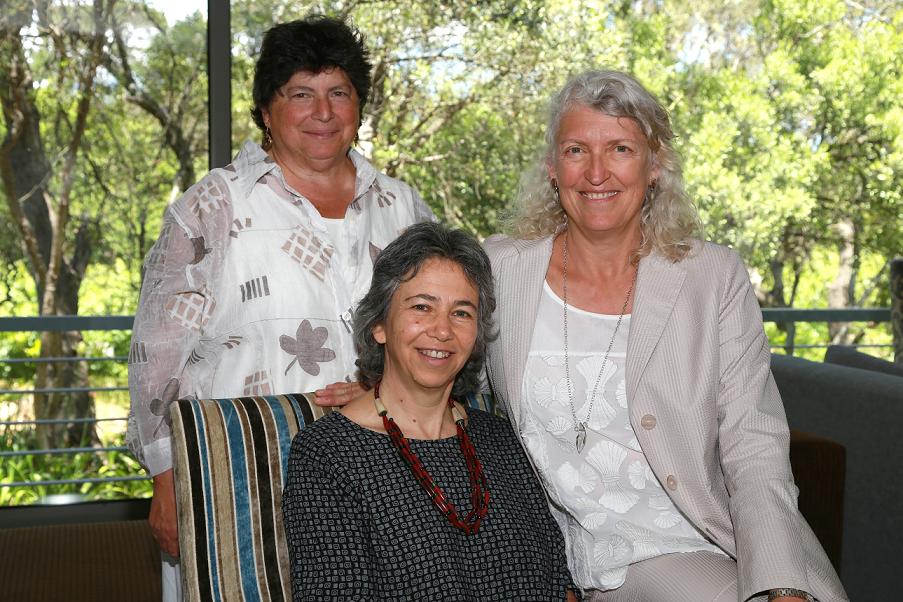
Cynthia Cohen, Kim Berman and Michelle LeBaron at STIAS (Photo credit: Hennie Rudman, SSFD)
“The arts create a space for the conversations that just don’t happen to happen,” said Michelle LeBaron. “They allow us to say the things that can’t be said directly. They are a crucible for our thoughts.”
LeBaron (of the University of British Columbia) was presenting a summary of the work of the Theory and Practice of Social Transformation through the Arts project at a STIAS fellows’ seminar with her colleagues Kim Berman (University of Johannesburg) and Cynthia Cohen (Brandeis University). (A fourth member of the team, Kitche Magak of Maseno University in Kenya, could not be present.) The project forms part of the broader STIAS theme Being Human Today.
“Artists are often on the margins, seeing many perspectives rather than serving one,” she continued. “We are examining how art can work effectively in some of the troubling issues of our time to foster social cohesion across differences.”
The project is tackled from multiple disciplinary and geographic perspectives, and aims to use case studies to illustrate how the arts can and do play positive roles in engaging and transforming conflicts. This unique initiative blends South African, Kenyan, US American and Canadian scholarship, creative work and wisdom to explore how the arts (across the spectrum – from dance and theatre to the visual arts) are optimally used and the best ways to measure success. Informed by case studies in diverse sites including Kisumu, Kenya and Limpopo Province, South Africa, the group hopes to advance understandings of the role of the arts in strengthening communities, smoothing fault lines and addressing inequities while offering ways to voice unspeakable truths and foster resilience. The project intends to hold two international research colloquia at STIAS bringing together global experts—artists and scholars—on the arts and social transformation. It is hoped the work will contribute to strengthening local and global capacities to build peace and address fallout from economic restructuring and social upheavals.
Speaking from her personal history and involvement in the Artist Proof Studio, Kim Berman said: “Doing this work in South Africa gives the opportunity to engage with a long tradition of the arts in social transformation. There is no doubt that art and culture played an important role in dismantling apartheid and rebuilding social cohesion,” she continued. “The Artist Proof Studio, for example, paralleled the growth of democracy in South Africa. It offers not only creative and technical skills but also active citizenship.”
“Art is an opportunity to see ourselves in relation to others – to make our own stories. It is a way of envisioning a different reality, imaging a different vision and re-identifying,” she said.
“South Africa’s struggle and transition anchors it as a place of hope in the world,” commented Michelle LeBaron.
Using examples from work in Canada and Latin America, the presentation specifically focused on the related concepts of resilience, agency, identity and moral imagination.
Acting together on the world stage
“Reconciliation is a kind of reciprocal healing,” said Cynthia Cohen, “Artists move into a delicate space which deepens one’s understanding of self and others.”
“It’s not possible to deal with memory just through rational processes – you have to deal with feelings,” she added, quoting from her film. “The past is always subject to the creative force of imagination.”
“We act together on the world stage and need to strengthen our capacity to imagine a different future,” she said.
Acknowledging that art can be used to galvanise people to do terrible things,the focus of the art and social transformation inquiry is on the ethical use of aesthetic energy to foster fairness and social justice. “Art can be deployed to provoke or soothe. Our focus is trying to get people to engage rather than to leap to judgement,” continued Cynthia.
“It’s important to understand what counts as peace-building art,” added Michelle. “This often has to do with the space you are inviting people into. We include artist-based, community-based and collective ritual forms of art.”
“However, as researchers we don’t aim to interpret for others,” she continued. “The person who frames the narrative or artwork should be the storyteller themselves. The aim is to honour people’s voices in context. Research then finds the patterns.”
“It’s about the use of theatre or dance, for example, as a route into conversation and into feeling,” she added. “For example, dance can allow us to feel what fairness feels like by embodying it.”
“Drawing on our experience and practices as scholars and artists, the project aims to generate and disseminate knowledge in innovative and animated ways to different audiences via the colloquia and other events, including our on-goingwork on a book entitled Artful Change: How Creative Communities Transform,” said Michelle.
She ended the presentation quoting M.C. Richards:
“The arts give us ways to imagine a kind of peace that includes the freedom to conflict, a kind of warmth that includes the freedom to withdraw, a kind of union that asks for free and unique individualities, a kind of good that grants the mystery of evil, a kind of life that bears death within it like a seedforce.”
Michelle Galloway: Part-time media officer at STIAS
